The Acer Swift 3 SF315-41 Review: Ryzen Meets Laptop
by Brett Howse on May 3, 2018 8:00 AM EST- Posted in
- Laptops
- Acer
- AMD
- Ryzen
- Ryzen Mobile
- Raven Ridge
GPU Performance: Vega at 15-Watts
We’ve been stuck in a bit of a rut with laptops lately. Intel has been offering solid CPU performance for the past several years, but their integrated graphics solution, while excellent for media playback and desktop usage, struggles under any sort of 3D load. Enter the Vega GPU in Ryzen.
Vega, if you follow GPUs, is the current generation GPU that AMD offers for the desktop, but they’ve also modularized it to be able to pack it into a 15-Watt SoC. The Ryzen 5 2500U and Ryzen 7 2700U are pretty similar on the CPU side, with only 200 MHz of frequency separating them, but on the GPU side, AMD offers 8 Radeon Vega CUs in the 2500U, and 10 Vega CUs in the 2700U. As well, the higher-level model offers a higher maximum boost frequency of 1300 MHz on the 2700U versus 1100 MHz on the 2500U.
This is full Vega as well. For a deep dive, check out the Vega launch article, but this U series SoC offers the same features as its bigger desktop cousins, such as Rapid Packed Math, the improved geometry engine, and of course, the media blocks, such as 10-bit HEVC hardware offload, and VP9 hardware as well.
The Acer Swift 3 was run through our standard laptop GPU suite, and unlike the Intel 15-Watt parts, we ran it through the full suite. We’re in the midst of introducing a 2018 laptop GPU suite, but like the CPU tests, it’s important to have more data even if the games are older.
Looking at our comparisons, we’ve got a wide range. The Surface Book 2 offers a very powerful NVIDIA GTX 1060 GPU, in the same 15-inch size as the Acer Swift 3. The Surface Pro tablet is one of the few models we’ve seen with Intel’s Iris GPU, offering double the execution units over the normal HD620 or UHD620 found in the ASUS ZenBook 3.
3DMark
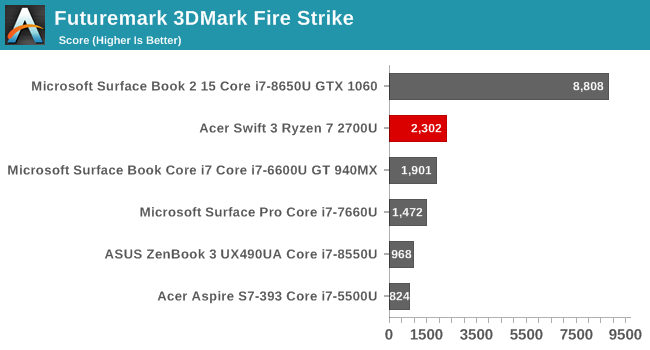
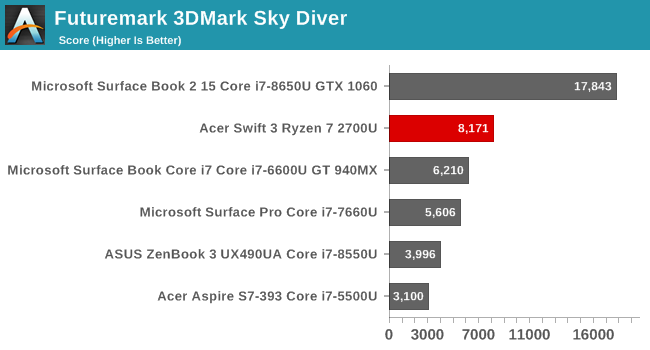
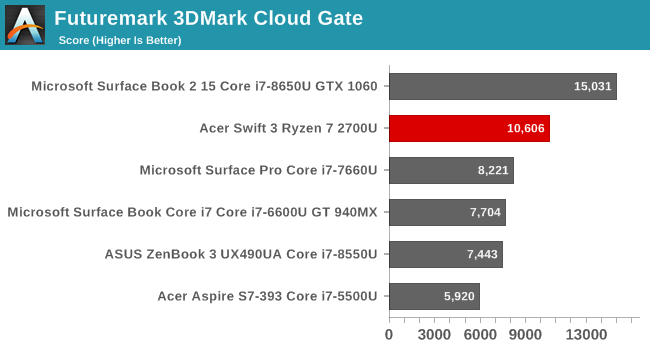

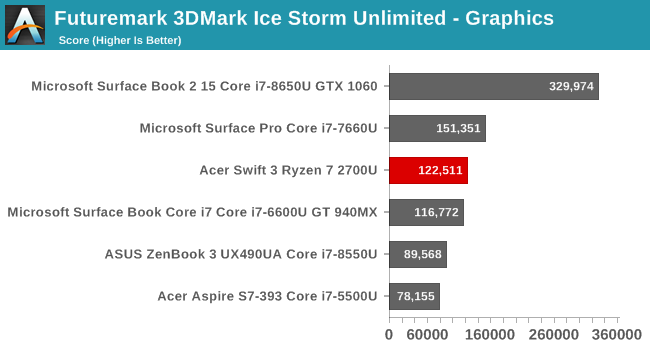
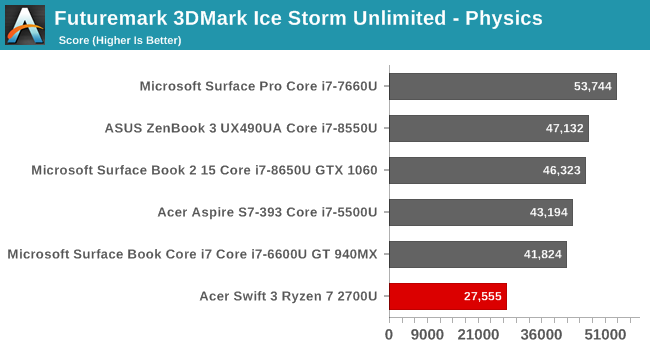
There’s a lot of interesting data to look at here. 3DMark offers several tests of increasing complexity, with the order of most demanding to least demanding being how they are presented above, with Fire Strike being the most demanding, and Ice Storm Unlimited the least.
Ryzen mops the floor with Intel’s GPU in any specification, including the Iris model. On Fire Strike, the CPU is the smaller factor, and the GPU runs away with it. As the tests get less demanding, they become more CPU bound though, and the less performant Zen cores bring down the overall results. That’s most obvious in the Ice Storm test, where we record the individual scores for GPU and CPU as well. The Physics result is a CPU bound test, and Intel’s ILP is clearly stronger.
GFXBench
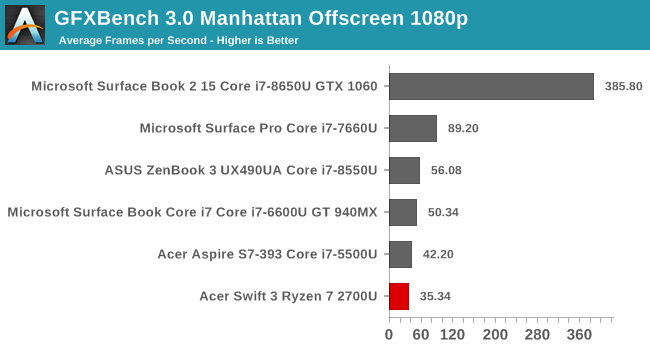
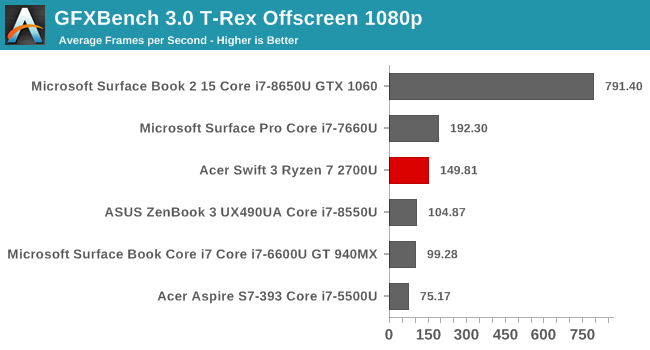
Although a benchmark geared towards smartphones and tablets, it’s always interesting to see how low-power laptops perform, even if the results are not 1:1 comparable. Here we seem to run into an issue with AMD’s OpenGL drivers, which are well behind in the Manhattan test compared to the Intel iGPU. Luckily for AMD, OpenGL isn’t a big focus right now, so despite the poor result, it’s not going to impact very many people.
Dota 2
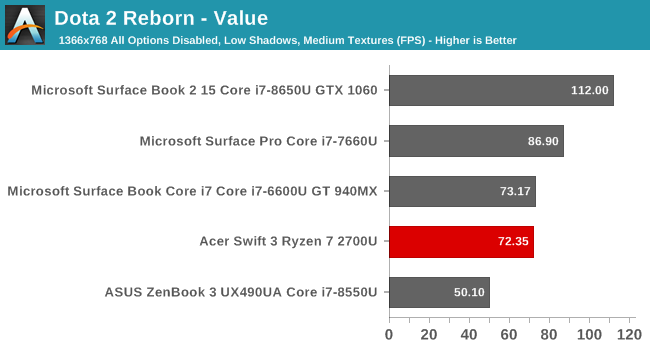
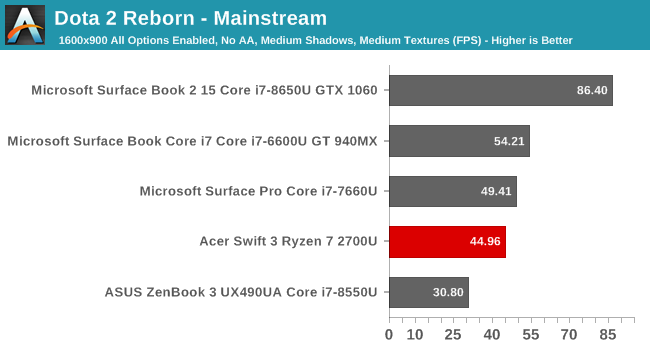
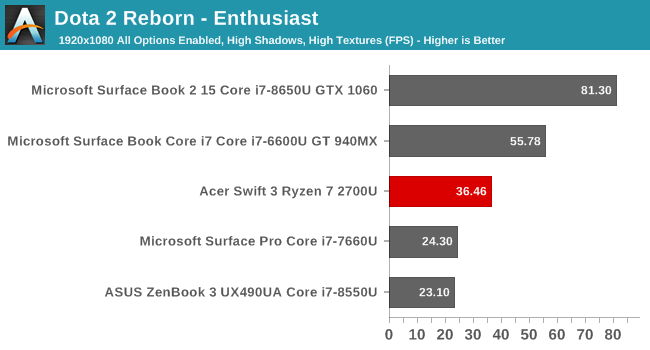
On most 15-Watt laptops, this is the only gaming benchmark we even test, because it’s one of the few that’s at least playable on low-end hardware. It’s actually CPU bound with even modest GPUs, but we can see the Ryzen 7 2700U easily surpasses the Core i7-8550U at all levels. The Surface Pro though with Intel Iris is able to stay ahead until the 1080p level thanks to the CPU performance and larger Iris GPU.
Tomb Raider
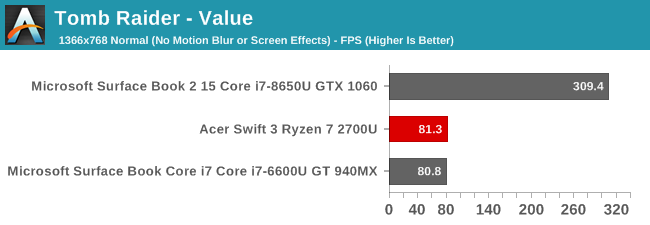
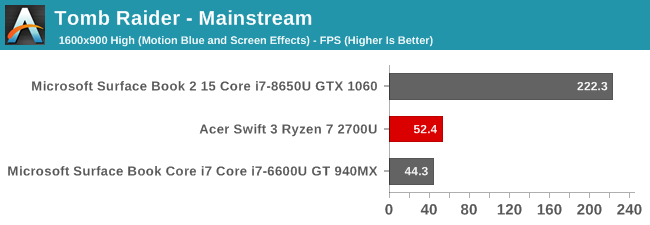
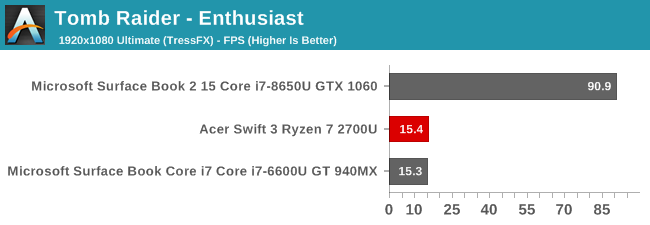
Although several years old now, the original Tomb Raider reboot is still a great looking game, and at maximum settings can be punishing to laptop GPUs. But it’s important to note that the Ryzen 7 is easily playable at low to medium settings.
Rise of the Tomb Raider

Newer, and even more demanding, Rise of the Tomb Raider is still a bit out of reach for even the Ryzen integrated GPU.
Civilization 6

Once again, Civ VI is playable on low settings, especially since it’s not a twitchy game.
Bioshock
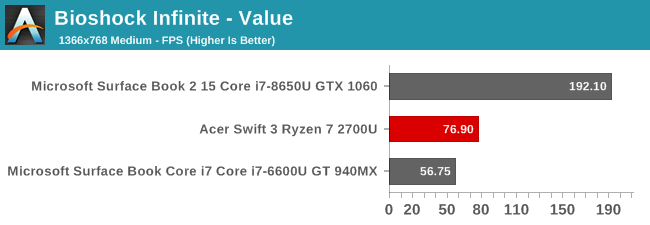
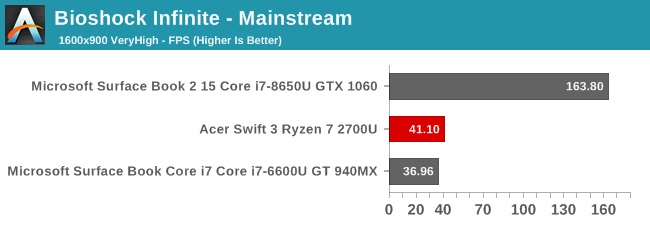
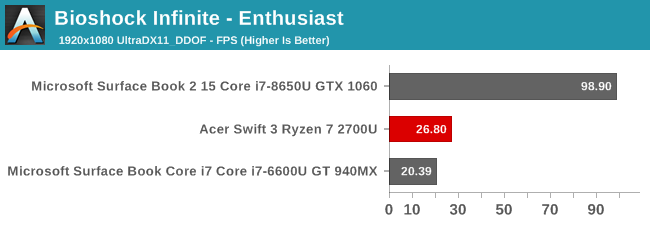
It’ll be sad to put this game to rest in our test suite since we have a tremendous amount of data for it, but it’s a good test for the kind of game you could expect to play well on a device with an integrated Vega GPU, and the Ryzen 7 performs quite well unless you max out the settings.
Shadow of Mordor

While getting close to the limits of playable, you could get by on Shadow of Mordor on lighter settings.
Grid Autosport



This game was very playable on the integrated graphics, although at maximum settings it’s kind of on the edge.
GPU Conclusion
For the longest time, we’ve been wondering if Intel’s GPU limits are due to architecture or TDP, since they’ve not really improved much over the years. Even the Iris graphics struggle. AMD has proven that theory wrong. Despite sharing just 15-Watts between the CPU and GPU, Ryzen 7 delivers respectable performance from the GPU, allowing gaming on integrated graphics with quite a bit of success. No, it can’t compete with the GTX 1060 in the Surface Book 2, but it does outperform the GT 940MX in the original Surface Book. The GPU in the Ryzen 7 2700U is just impressive.










78 Comments
View All Comments
jaydee - Thursday, May 3, 2018 - link
Looking forward to Ryzen hitting the business line notebooks (Elitebook/Latitudes). Lot of employees at my company are still being given the woeful Elitebook 745 G3 (Carrizo) as of today, as band new laptops for a 4 year cycle...Jimster480 - Monday, May 28, 2018 - link
They did, and the offerings are atrocious and insanely overpriced.Valantar - Thursday, May 3, 2018 - link
This is very promising in terms of performance, even if AMD still needs to convince OEMs to build more premium SKUs with Ryzen mobile. Also, that base platform power draw needs fixing, for sure. Wonder how much of that is RAM, but I suppose that would be pretty much impossible to measure.Related to that: why doesn't RAM have some sort of turbo/power saving implementation like CPUs? Given that this likely runs dual channel 1.2V DDR4 at ~2400MT/s, couldn't the base power draw benefit massively from downclocking the RAM to, say, 1600MT/s at idle and simultaneously lowering voltage? I get that this isn't part of the DDR4 spec, and that the ICs and DIMMs as such aren't tested or certified for lower voltages and speeds, but the lack of dynamism in RAM is starting to feel old. The same goes for high-speed desktop RAM, really - why run 3600MT/s RAM idling at the desktop? It can't possibly be /that/ hard to implement a two-state (e.g. "low power" and "normal") dynamic system that's directly tied to other system loads (not just CPU, but GPU, RAM, network and disk activity too). Tuning the boost/de-clock triggers and control algorithms would likely require a bit of work, but is this really that hard to do?
I suppose this could trip up a few applications that are highly reliant on timely RAM access, but those can't be very common in normal consumer usage - and I don't envision this catching on in datcenters and the like. Might that be why we still haven't seen something like this, as businesses and server OEMs don't care?
DanNeely - Thursday, May 3, 2018 - link
If idle link throttling of DDR ever happens, I'd expect it to happen first on mobile, and then work its way up though LPDDR, to regular DDR specs. OTOH GDDR has been able to do this for a while, so it's definitely doable without seriously impacting peak performance. GPUs are power pigs, and lower idle power has been a major improvement over the last decade; but it's a segment not willing to sacrifice performance at the top to get it.You're probably right about it never making it to the data center. I've read that a number of the major cloud platforms have disabled CPU clock throttling and run at full speed 24/7 regardless of the actual load because serving responses at low speed and/or boosting back up from idle to full speed have measurable impacts on latency and the major web companies care about every millisecond there.
neblogai - Friday, May 4, 2018 - link
Gaming benchmarks show mobile Raven Ridge processors doing exactly that: RAM clock changes in the game, 933-1066-1200. You can see such behaviour in TechEpiphany's videos on youtube. However- because this is not something seen before- these readings are semi-discarded. In would be great if someone tested it properly, or asked AMD if this is how it really works, and is not an error by monitoring software.HStewart - Thursday, May 3, 2018 - link
I think for comparison, it would have been nice to test the Intel version of same model - I found it interesting that 2700 version was more expensive than the Intel with MX150. Also the Intel model was less weight which tells me Intel components are more compact. The 2700 model had more ssd but that should not be that way.Cooe - Thursday, May 3, 2018 - link
It's because of the doubled SSD size that the 2700 model is more expensive obviously.Jimster480 - Monday, May 28, 2018 - link
Its not that because the AMD machines are relegated to cheap SATA bottom of the barrel drives and ultra cheap screens. The price is just Intel making sure that nobody is going to make a competitive notebook.This laptop doesn't even land in "mainstream" it lands in "ultra budget with such a big price nobody will buy it". The screen, SSD, battery, wifi, chassis, keyboard are all unacceptable for this price range and Acer knows it aswell. But the check they receive from intel outweighs the obvious lack of sales they will have for this model.
Stuka87 - Thursday, May 3, 2018 - link
I would be surprised if you could tell the weight difference between the two. Its 4 ounces. And the Intel is cheaper because its SSD is half the size.Krysto - Thursday, May 3, 2018 - link
Still only 8GB of RAM?! Come on.